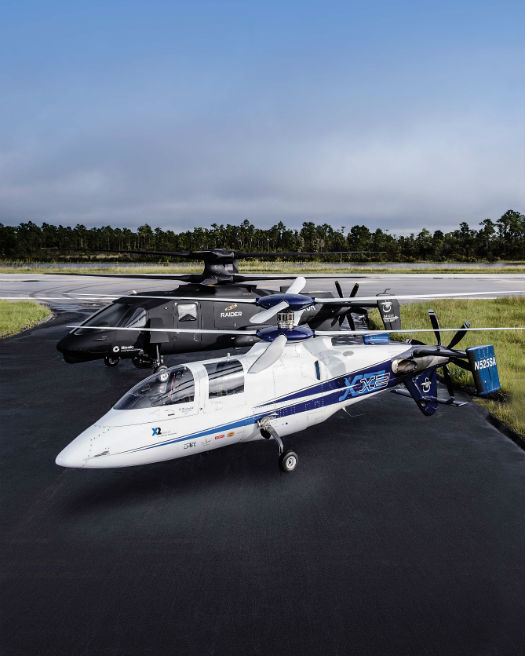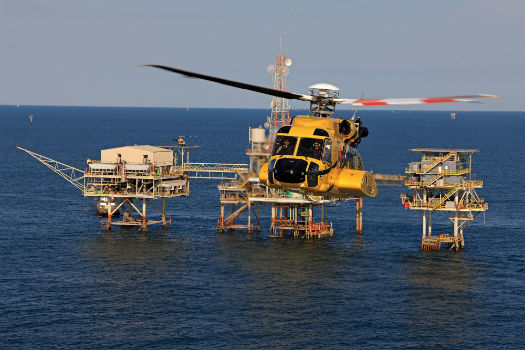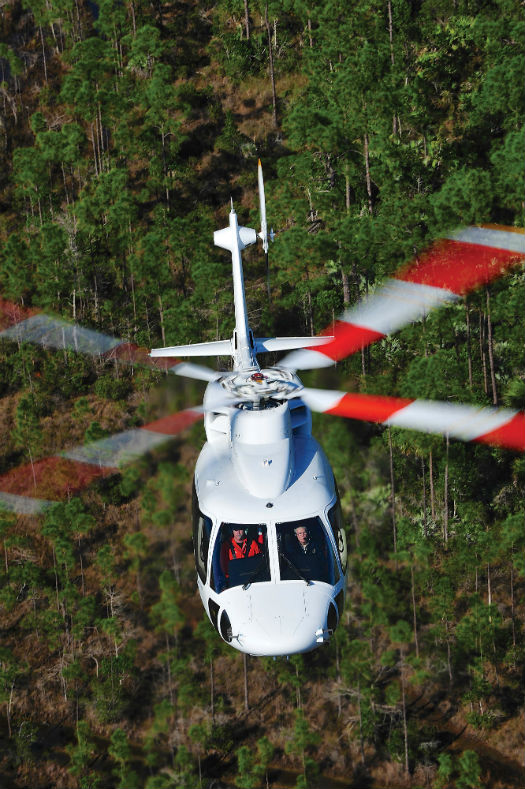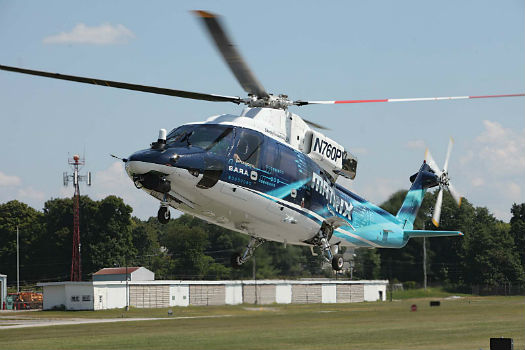
Through its intelligence research, Sikorsky is actively seeking ways to increase the availability and efficiency of its existing commercial workhorses, the S-92 and the S-76. Ted Carlson Photo
“Intelligence” is a word that’s generally associated with conscious thought — as in, Einstein had a lot of it; many reality TV stars do not. But that’s not the only way to think about intelligence, and in fact, there are a lot of “smarts” hard-wired into the human body. Consider the example of running with a weak knee. As the knee approaches the point of injury, it will start to hurt, telling the body to back off before more damage occurs. The conscious brain may override that impulse — perhaps in order to finish a marathon — but there will be consequences to ignoring the body’s good sense.
Imagine if a helicopter could do the same thing: identify when a component is about to be overstressed, and automatically adjust its flight profile to prevent damage or excessive fatigue — possibly with an input so minor, the pilot wouldn’t even notice it. Component lives could be dramatically extended, and components themselves could be made lighter and more efficient, because they wouldn’t have to be overdesigned to tolerate unpredictable abuse.
What else might such a self-aware helicopter be able to do? Perhaps it could identify parts in imminent need of replacement, and automatically alert the manufacturer to have those parts in stock. Or, if something were to fail within the aircraft, it could tell its maintainers exactly what went wrong and how to fix it, sparing them hours or days of troubleshooting. When you start to think about it, you can come up with countless ways in which a helicopter with that kind of built-in “intelligence” could save money, time, and hassle for the people who operate it.

Sikorsky Innovations is usually grabbing headlines for aircraft development programs such as the X2 or S-97 Raider. Intelligence research is not quite as glamorous, but it’s no less important to the company. Sikorsky Image
That’s precisely the vision of Sikorsky Aircraft, which has made intelligence one of the three pillars of its internal technology development organization, Sikorsky Innovations. You may be familiar with the other two pillars of Innovations — speed and autonomy — which have led to high-profile aircraft programs in the form of the X2 technology demonstrator, S-97 Raider, and the Sikorsky Autonomy Research Aircraft (SARA), an unmanned S-76. The company’s intelligence research isn’t quite as glamorous; it doesn’t have a marquee aircraft program to draw attention to it. Yet, of the three pillars, intelligence may be the first to have a revolutionary impact on how we fly and maintain helicopters.
A Model for the Future
According to Sikorsky Innovations vice president Chris Van Buiten, ”intelligence” for the company falls into two categories: “making the aircraft more intelligent, and making the operations of the aircraft more intelligent.” Neither is an entirely new concept for Sikorsky, which has long been a leader in health and usage monitoring systems (HUMS) and fleet analytics with its S-92 helicopter.
As the first helicopter to be certified under the stringent transport-category requirements of U.S. Federal Aviation Regulations part 29, the S-92 received the 2002 Robert J. Collier Trophy for its promising new technologies, including an onboard system to monitor the health of all critical drive-system components. When the S-92 entered service, Sikorsky began collecting fleet-wide HUMS and operating statistics for the aircraft, giving it what is now an enormous pool of data about the helicopter and its components.

Sikorsky partnered with PHI, Inc. to develop Rig Approach for the S-92. In coming years, Sikorsky would like to build on that model of dropping new capabilities into aircraft through software. Ted Carlson Photo
Collecting data is one thing; figuring out how to interpret and apply it is another. The latter has been an intensive, sometimes difficult learning process for Sikorsky, and “we’re still learning,” said Sikorsky vice president of Research and Engineering Mark Miller. Over the past decade, however, Sikorsky has made enormous strides in fleet analytics, not only in monitoring for failure prevention, but also in more advanced applications. Most notably, in 2012, the company obtained Federal Aviation Administration (FAA) approval to grant one-time service life extensions for certain S-92 main rotor hubs based on actual HUMS data from each helicopter — a tangible way in which a self-aware aircraft can deliver real value to customers.
The S-92 fleet analytics program is an important model for future intelligence advancements, both evolutionary and revolutionary. On the evolutionary side, Sikorsky hopes to obtain similar service life extensions for other S-92 components on the basis of HUMS data. It will also be applying the analytical expertise it has developed through the S-92 to the S-76D, which is entering service with even more sophisticated sensors for health and usage monitoring.
On the revolutionary side, Sikorsky’s groundwork with the S-92 should allow the company to take advantage of “gee-whiz” sensing and autonomy technologies in practical ways that benefit customers in the near-term. Many of those technologies are being developed through the “autonomy” pillar of Sikorsky Innovations, specifically through the Matrix Technology research program that was first announced in 2013. That program continues to make great strides, with SARA performing autonomous takeoffs and landings and flight in obstacle-rich environments. Speaking at Heli-Expo 2015 in March, Van Buiten predicted, “You’re going to see a lot of MATRIX technology demonstrations this year.”

The capabilities being developed through Sikorsky’s unmanned Black Hawk research could be used not only in fully autonomous aircraft but also in optionally piloted helicopters, which might fly manned missions during the day, and unmanned cargo resupply missions at night. Skip Robinson Photo
With regulatory and cultural acceptance of unmanned aircraft systems lagging well behind their technology, it may be a while before vehicles like SARA take over routine commercial helicopter operations. Yet it is the autonomy technologies being developed through the MATRIX program that offer some of the greatest promise for advancing the capabilities of manned aircraft. “Intelligence in particular looks to autonomy,” said Sikorsky’s Intelligence Technologies senior program manager Simon Gharibian, explaining that the sophisticated sensing technologies required for autonomous flight are very much in line with the intelligence goal of a self-aware aircraft. “From the efficiency standpoint it makes a lot of sense to be very tightly tied.”
It’s the combination of autonomous flight capabilities with health and usage monitoring that would enable things like load-limiting control laws, which would have the aircraft tweak flight profiles to avoid overstressing components, in the same way that the body automatically reacts to pain to avoid injury. Autonomous capabilities could optimize flight operations in other ways, too. For example, helicopters in cruise flight could have an optional setting to minimize fuel consumption, similar to the “eco” mode in cars.
Improvements like these wouldn’t have to arrive in the form of an expensive new airframe — they could be introduced progressively, as software applications. Here, too, Sikorsky has already set a precedent through its S-92 program with “Rig Approach,” developed in partnership with PHI Inc. Rig Approach allows operators to fly automated approaches to offshore rigs and platforms, and is retrofittable to aircraft already in service. According to Miller and Van Buiten, Sikorsky would like to continue with this model of dropping new capabilities into aircraft through software, ideally releasing one or two new apps per year. As Van Buiten put it, “It’s going to be these incremental insertions of functionality.”

The S-76D is entering service with even more sophisticated sensors for health and usage monitoring than are found in the S-92. Mike Reyno Photo
Making it Work
With intelligence, as with most things, the devil is in the details. “When you start peeling back the onion, it’s a lot more complicated than you might think,” Gharibian acknowledged. Consequently, much of Sikorsky’s intelligence research is focused on the fine-grained particulars of data analysis, and on developing robust systems that work reliably and consistently. For example, Gharibian said, “Part of the intelligence pillar is ensuring the sanctity of the data coming off the aircraft. The moment you have a gap, you can’t know what happened during that gap, and your argument goes out the window.” So, the intelligence mandate includes developing systems that ensure absolute traceability for each component, even when components are swapped between airframes.
Those types of robust systems will become even more critical if Sikorsky is to take full advantage of the potential of self-aware aircraft in future helicopter designs. Currently, aircraft are designed based on an assumed usage spectrum, which is inherently conservative because it’s the composite worst-case of all predicted operations. As a result, parts are often (although, unfortunately, not always) thicker and heavier than they need to be for less severe, routine operations. Theoretically, such parts could be optimized for aircraft that are able to monitor themselves and intervene to avoid inadvertent overstresses. “If you’re factoring this type of methodology into a new design, your parts are lighter,” Gharibian said. However, he continued, giving up the security afforded by an extra layer of metal is not something to be done lightly. Not only does the FAA “expect us to be extremely rigorous,” he said, “We’re Sikorsky. . . . It’s all got to be aligned with our fanatical focus on safety.”

Sikorsky’s MATRIX technology research program continues to make great strides, the company said. SARA, an autonomous S-76, is a testbed for the program. Sikorsky Photo
According to Miller, Sikorsky is finding that its increased emphasis on intelligence is demanding skill sets beyond those traditionally possessed by aerospace engineers. “This is a different talent set for us,” he said, noting that Sikorsky is seeking out that talent in a number of ways. One of them is through external acquisitions and recruitment. For example, several years ago, Sikorsky acquired the engineering firm Impact Technologies, which specializes in complex asset condition based maintenance, and prognostics and health management. Sikorsky has also created a new technical fellow position for “big data,” recognizing that the predictive analytics being pioneered in fields such as finance and medicine are also very relevant to aircraft intelligence. “We look to get people who aren’t necessarily aerospace people,” Miller said, explaining that the company wants “to bring in new sets of eyes and new kinds of ways to solve problems.”
However, Sikorsky is also finding fresh talent and creative approaches within its existing ranks, which currently include around 4,500 engineers. Notably, the company is sponsoring an annual internal competition called “iPRIZE,” which encourages Sikorsky employees to pitch their bright ideas for improving products and processes. Finalists receive time and funding to refine their ideas before presenting them to the company’s senior engineering leadership in a setting that resembles the reality TV show Shark Tank.
“That’s been a great source of non-incremental, revolutionary ideas,” said Gharibian, remarking that, of last year’s eight finalists, six concepts were deemed worthy of further funding. He also pointed out that five of those eight finalists related to intelligence — evidence of the relevance and importance of intelligence to Sikorsky’s future. “Sikorsky’s effectively made the commitment to triple their investment in this area on an annual basis,” he said. “The intelligence technology is just so pervasive.”





